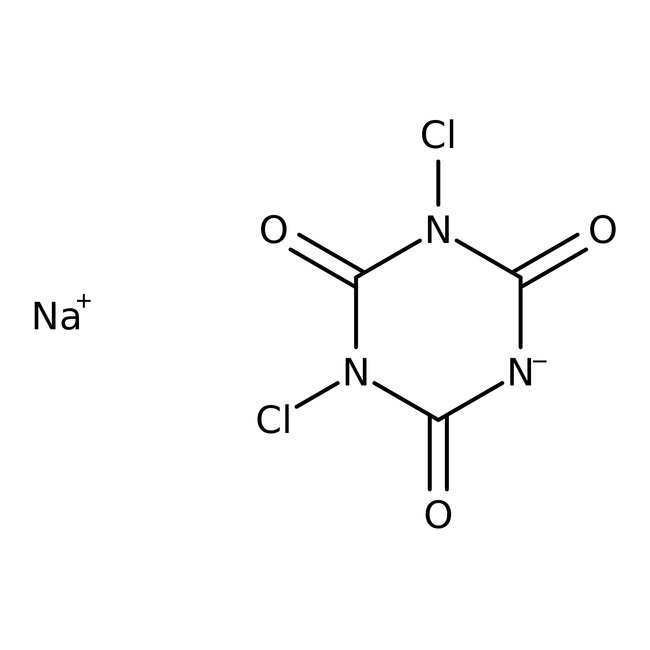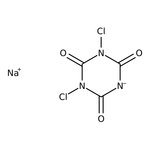Search Thermo Fisher Scientific
Thermo Scientific Chemicals
Dichloroisocyanuric acid sodium salt, 97% (dry wt.)
CAS: 2893-78-9 | C3HCl2N3NaO3 | 220.949 g/mol
Catalog number ALFB23504.36
View Price:Sign InSign in to see your account pricing. Need an account? Register with us today.
Quantity:
500 g
Specifications
Chemical Name or MaterialDichloroisocyanuric acid sodium salt
CAS2893-78-9
Health Hazard 1H272-H302-H319-H335
Health Hazard 2GHS H Statement
H272-H302-H319-H335
May intensify fire; oxidizer.
Harmful if swallowed.
Causes serious eye irritation.
May cause respiratory irritation.
H272-H302-H319-H335
May intensify fire; oxidizer.
Harmful if swallowed.
Causes serious eye irritation.
May cause respiratory irritation.
Health Hazard 3P210-P220-P221-P261-P264b-P270-P271-P280-P301+P312-P304+P340-P305+P351+P338-P312-P330-P370+P378q-P501c
View more
Sodium dichloroisocyanurate can be used as a reagent for N-monochlorination and dehydrochlorination of amino esters. It is also a reagent for chlorination to detect ammonium via formation of colored zebra-bands in a detecting tube.
This Thermo Scientific Chemicals brand product was originally part of the Alfa Aesar product portfolio. Some documentation and label information may refer to the legacy brand. The original Alfa Aesar product / item code or SKU reference has not changed as a part of the brand transition to Thermo Scientific Chemicals.
Applications
Sodium dichloroisocyanurate can be used as a reagent for N-monochlorination and dehydrochlorination of amino esters, synthesis of antimicrobial polyurethane additives to control biofilm. It is used as a emergency disinfectant in drinking water, widely used cleansing agent. It is also a reagent for chlorination to detect ammonium via formation of colored zebra-bands in a detecting tube.
Solubility
Soluble in water.
Notes
Store in a cool, dry conditions, in well sealed conditions. Store away from oxidizing agents.
Sodium dichloroisocyanurate can be used as a reagent for N-monochlorination and dehydrochlorination of amino esters, synthesis of antimicrobial polyurethane additives to control biofilm. It is used as a emergency disinfectant in drinking water, widely used cleansing agent. It is also a reagent for chlorination to detect ammonium via formation of colored zebra-bands in a detecting tube.
Solubility
Soluble in water.
Notes
Store in a cool, dry conditions, in well sealed conditions. Store away from oxidizing agents.
RUO – Research Use Only
General References:
- Tatsuaki Hori; Keizou Niki; Yoshiaki Kiso; Tatsuo Oguchi; Yuki Kamimoto; Toshiro Yamada; Masahiro Nagai; Tatsuaki Hori; Keizou Niki; Yoshiaki Kiso; Tatsuo Oguchi; Yuki Kamimoto; Toshiro Yamada; Masahiro Nagai. Ammonium detection by formation of colored zebra-bands in a detecting tube. Talanta. 2010, 81, (4-5), 1467-1471.
- S Devin McLennan; Lauren A Peterson; Joan B Rose. Comparison of point-of-use technologies for emergency disinfection of sewage-contaminated drinking water. Applied and Environmental Microbiology. 2009, 75 (22), 7283-7286.
- Reagent for N-chlorination of primary and secondary amines, particularly useful for chlorination of hindered amines: Synth. Commun., 18, 2135 (1988).



